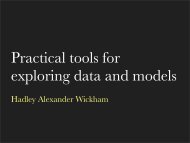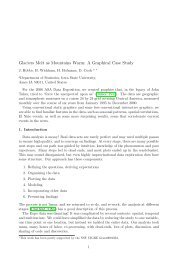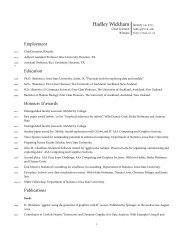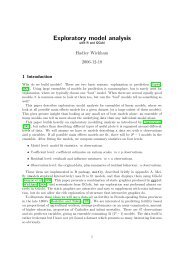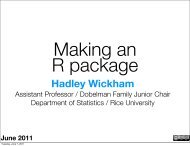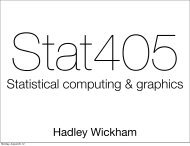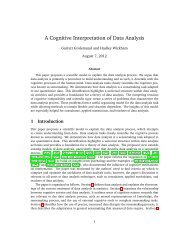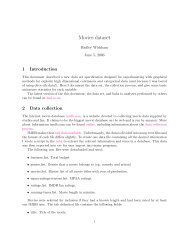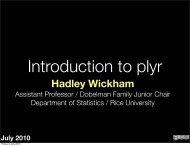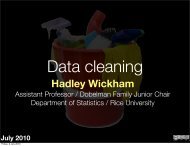Statistical inference for exploratory data analysis ... - Hadley Wickham
Statistical inference for exploratory data analysis ... - Hadley Wickham
Statistical inference for exploratory data analysis ... - Hadley Wickham
You also want an ePaper? Increase the reach of your titles
YUMPU automatically turns print PDFs into web optimized ePapers that Google loves.
Downloaded from<br />
rsta.royalsocietypublishing.org on January 7, 2010<br />
Phil. Trans. R. Soc. A (2009) 367, 4361–4383<br />
doi:10.1098/rsta.2009.0120<br />
<strong>Statistical</strong> <strong>inference</strong> <strong>for</strong> <strong>exploratory</strong> <strong>data</strong><br />
<strong>analysis</strong> and model diagnostics<br />
BY ANDREAS BUJA 1 ,DIANNE COOK 2, *, HEIKE HOFMANN 2 ,<br />
MICHAEL LAWRENCE 3 ,EUN-KYUNG LEE 4 ,DEBORAH F. SWAYNE 5<br />
AND HADLEY WICKHAM 6<br />
1 Wharton School, University of Pennsylvania, Philadelphia, PA 19104, USA<br />
2 Department of Statistics, Iowa State University, Ames, IA 50011-1210, USA<br />
3 Fred Hutchinson Cancer Research Center, 1100 Fairview Avenue, Seattle,<br />
WA 98109, USA<br />
4 Department of Statistics, EWHA Womans University, 11-1 Daehyun-Dong,<br />
Seodaemun-Gu, Seoul 120-750, Korea<br />
5 Statistics Research Department, AT&T Laboratories, 180 Park Avenue,<br />
Florham Park, NJ 07932-1049, USA<br />
6 Department of Statistics, Rice University, Houston, TX 77005-1827, USA<br />
We propose to furnish visual statistical methods with an inferential framework and<br />
protocol, modelled on confirmatory statistical testing. In this framework, plots take on<br />
the role of test statistics, and human cognition the role of statistical tests. <strong>Statistical</strong><br />
significance of ‘discoveries’ is measured by having the human viewer compare the plot<br />
of the real <strong>data</strong>set with collections of plots of simulated <strong>data</strong>sets. A simple but rigorous<br />
protocol that provides inferential validity is modelled after the ‘lineup’ popular from<br />
criminal legal procedures. Another protocol modelled after the ‘Rorschach’ inkblot test,<br />
well known from (pop-)psychology, will help analysts acclimatize to random variability<br />
be<strong>for</strong>e being exposed to the plot of the real <strong>data</strong>. The proposed protocols will be<br />
useful <strong>for</strong> <strong>exploratory</strong> <strong>data</strong> <strong>analysis</strong>, with reference <strong>data</strong>sets simulated by using a null<br />
assumption that structure is absent. The framework is also useful <strong>for</strong> model diagnostics<br />
in which case reference <strong>data</strong>sets are simulated from the model in question. This latter<br />
point follows up on previous proposals. Adopting the protocols will mean an adjustment<br />
in working procedures <strong>for</strong> <strong>data</strong> analysts, adding more rigour, and teachers might<br />
find that incorporating these protocols into the curriculum improves their students’<br />
statistical thinking.<br />
Keywords: permutation tests; rotation tests; statistical graphics; visual <strong>data</strong> mining;<br />
simulation; cognitive perception<br />
*Author <strong>for</strong> correspondence (dicook@iastate.edu).<br />
Electronic supplementary material is available at http://dx.doi.org/10.1098/rsta.2009.0120 or via<br />
http://rsta.royalsocietypublishing.org.<br />
One contribution of 11 to a Theme Issue ‘<strong>Statistical</strong> challenges of high-dimensional <strong>data</strong>’.<br />
4361<br />
This journal is © 2009 The Royal Society



